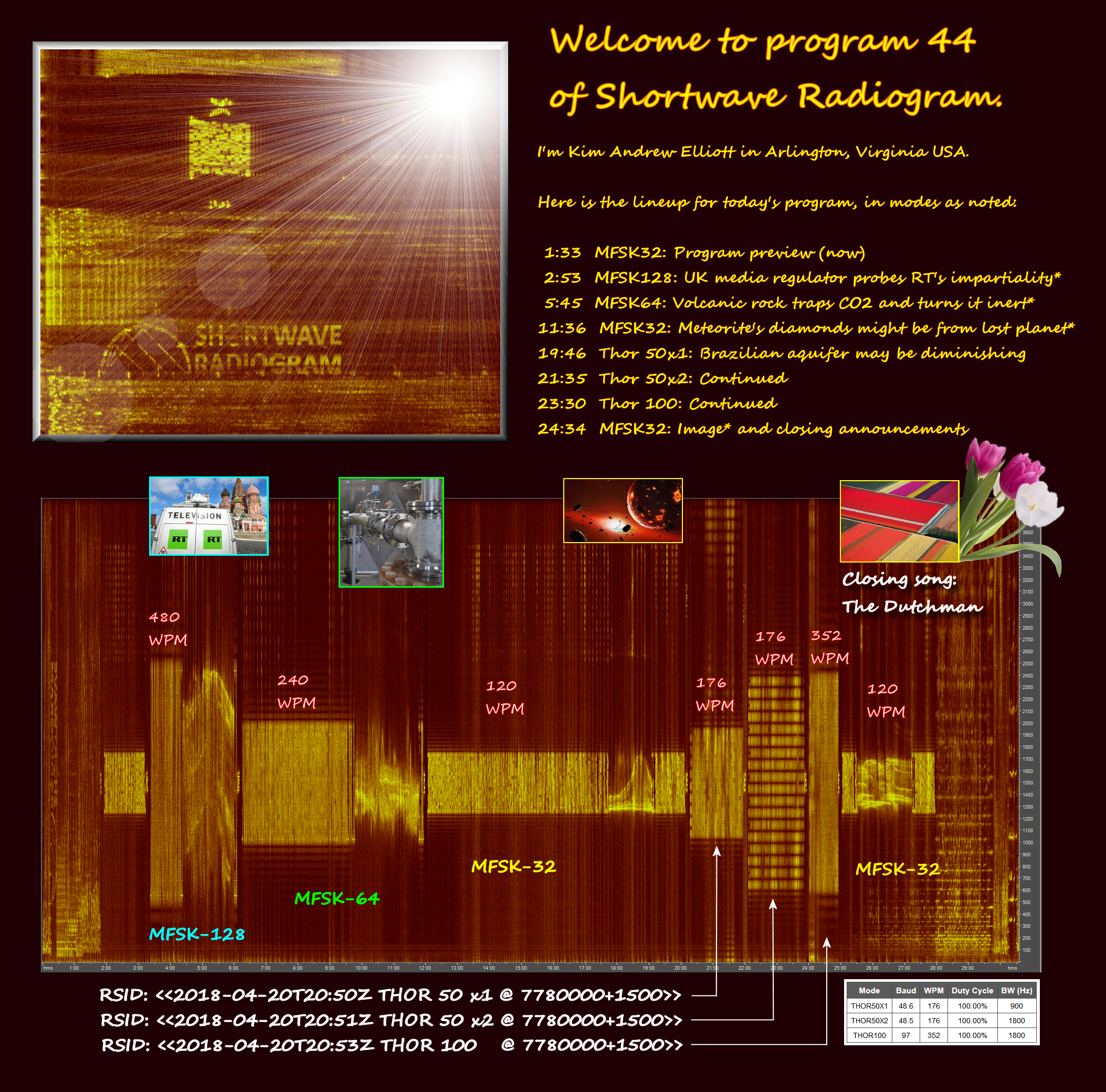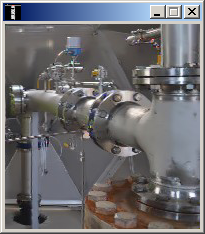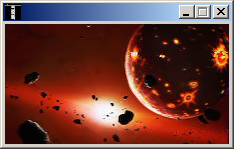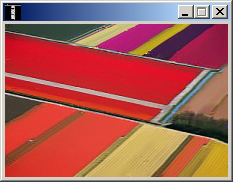http://www.rhci-online.net/radiogram/radiogram.htm
http://www.rhci-online.net/radiogram/radiogram.htm
|
RSID: <<2018-04-20T01:25Z MFSK-32 @ WRMI SYSTEM B-STREAM-9955000+1500>>
|
|
|
|
|
RSID: <<2018-04-21T15:30ZMFSK-32 @ 9400000+1500>>
|
Watch the progress of bald eagles Mr. President and The First
|
VLC or GOM media player:
|

RSID: <<2018-04-21T16:01Z MFSK-32 @ 9400000+1500>>
Welcome to program 44 of Shortwave Radiogram.
I'm Kim Andrew Elliott in Arlington, Virginia USA.
Here is the lineup for today's program, in modes as noted:
1:33 MFSK32: Program preview (now)
2:53 MFSK128: UK media regulator probes RT's impartiality*
5:45 MFSK64: Volcanic rock traps CO2 and turns it inert*
11:36 MFSK32: Meteorite's diamonds might be from lost planet*
19:46 Thor 50x1: Brazilian aquifer may be diminishing
21:35 Thor 50x2: Continued
23:30 Thor 100: Continued
24:34 MFSK32: Image* and closing announcements
* with image
Please send reception reports to
radiogram@verizon.net
And visit
http://swradiogram.net
Twitter:
@SWRadiogram
Shortwave Radiogram now changes to MFSK 128 ...
RSID: <<2018-04-21T16:03Z
MFSK-128 @
9400000+1500>>
This is Shortwave Radiogram in MFSK128 ...
From Radio Free Europe/Radio Liberty:
British Media Regulator Probes RT's Impartiality After Salisbury
Poisoning
18 April 2018
Britain's media watchdog is investigating whether Russian news
channel RT broke impartiality rules in its programs after a
former Russian double agent and his daughter were poisoned in the
English city of Salisbury last month.
Media regulator Ofcom warned on April 18 that TV Novosti, the
company which produces RT, could lose its British broadcasting
rights if it failed its "fit-and-proper" test.
"Until recently, TV Novosti's overall compliance record has not
been materially out of line with other broadcasters," Ofcom said
in a statement on April 18.
"However, since the events in Salisbury, we have observed a
significant increase in the number of programs on the RT service
that warrant investigation as potential breaches of the Ofcom
Broadcasting Code.
"Ofcom has today opened seven new investigations into the due
impartiality of news and current-affairs programs on the RT news
channel," the regulator said.
It said it would consider "all relevant new evidence, including
the outcome of these investigations and the future conduct of the
licensee."
Britain blames Russia for the March 4 poisoning of Sergei and
Yulia Skripal with a nerve agent -- a charge that Moscow denies.
Russia's Foreign Ministry has warned that British media outlets
will be forced to close Russian operations if Britain expels RT,
which used to be known as Russia Today.
In a statement, RT said that the channel's "editorial approach
has not changed since the events in Salisbury, and we will be
directly addressing this matter with the regulator."
"We are pleased to see that Ofcom has acknowledged RT's
compliance record has been in line with other broadcasters," the
statement said.
Russia's Embassy in London said that "this targeted scrutiny,
directed at one particular news organization and regarding one
particular issue, amounts to pressure against this specific
broadcaster."
"This increased scrutiny is sure to affect press freedom in
Britain," it added.
With reporting by Reuters and AFP
https://www.rferl.org/a/british-media-regulator-probing-rt-s-impartiality-after-salisbury-poisoning/29174828.html
See also:
https://www.voanews.com/a/britain-launches-probes-into-impartiality-of-russian-state-owned-broadcaster-rt/4354541.html
Sending Pic:221x146C;

Shortwave Radiogram now changes to MFSK64 ...
RSID: <<2018-04-21T16:05Z
MFSK-64 @
9400000+1500>>
This is Shortwave Radiogram in MFSK64
Please send reception reports to
radiogram@verizon.net
From Futurity.org:
How volcanic rock traps CO2 and turns it inert
Erika Ebsworth-Goold
18 April 2018
New research shows how effective injecting carbon dioxide (CO2)
into the volcanic rock basalt could be for fighting carbon
emissions.
Burning fossil fuels produces carbon dioxide. As the gas rises
and the atmosphere traps it, it retains heat as part of a process
called the greenhouse effect. The increased temperatures
associated with the greenhouse effect can cause melting ice caps,
higher sea levels, and a loss of natural habitat for plant and
animal species.
Environmental scientists trying to mitigate the effects of CO2
have experimented with injecting it deep underground, trapping
it. These trials have mainly taken place in sandstone aquifers,
however, the CO2 primarily remains present as a bubble that can
return to the surface if is there are fracture in the capping
formation.
A different approach using basalt flows as injection
sites—chiefly at the CarbFix site in Iceland and in Washington
state—has yielded dramatic results. Metals in basalt have the
ability to transform CO2 into a solid inert mineral in a matter
of months.
While the new method holds promise, the underground injections
can be imprecise, difficult to track and measure. The new
research sheds light on what happens underground after injecting
CO2 into basalt.
"In a field site, you inject the carbon dioxide in, and it's a
very open system," says Daniel Giammar, professor of
environmental engineering in the School of Engineering & Applied
Science at Washington University in St. Louis. "You can't get a
good constraint in terms of a capacity estimate. You know you
made some carbonate from the CO2, but you don't really know how
much. In the lab, we have well-defined boundaries."
To obtain a clearer, quantifiable look at carbon trapping rates
in basalt, Giammar collected samples of the rock from Washington
state, where researchers previously injected a thousand tons of
CO2 gas deep underground into a basalt flow. He placed the rocks
in small reactors that resemble slow cookers to simulate
underground conditions, and then injected CO2 to test the
variables involved in the carbonization process.
"We reacted it at similar pressure and temperature conditions to
what they had in the field, except we do all of ours in a small
sealed vessel," Giammar says. "So we know how much carbon dioxide
went in and we know exactly where all of it went. We can look at
the entire rock afterwards and see how much carbonate was formed
in that rock."
The lab kept the basalt in the pressurizers and followed up,
using 3D imaging to analyze their pore spaces at six weeks, 20
weeks, and 40 weeks. They watched moment to moment the CO2 turned
into mineral, saw the exact voids within the basalt it filled,
and observed the precise spots in the rock where the
carbonization process began.
Once they collected and analyzed all of the data, Giammar and his
team predicted that one cubic meter of basalt could convert 47
kilograms of CO2 into mineral. Researchers can use this estimate
as a baseline to scale up, quantifying how much CO2 entire areas
of basalt flow can effectively convert.
"People have done surveys of available basalt flows," Giammar
says. "This data will help us determine which ones could actually
be receptive to having CO2 injected into them, and then also help
us to determine capacity. It's big. It's years and years worth of
US CO2 emissions."
Giammar's lab is currently sharing its results with colleagues at
the University of Michigan, who will assist in developing a
computational model to further help researchers to look for a
solid fix for CO2 abatement. The researchers have also been
invited to take part in the second phase of the US Department of
Energy's Carbon Storage Assurance Facility Enterprise, or
CarbonSAFE, which investigates new technologies for CO2
abatement.
The researchers report their findings in the journal
Environmental Science & Technology Letters.
The US Department of Energy funded the research. Additional
collaborators are from the Pacific Northwest National Laboratory
and Washington University.
Source: Washington University in St. Louis
https://www.futurity.org/basalt-carbon-storing-conversion-1734812/
Image: A piping system that pumps CO2 emissions underground at
the Hellisheidi power plant in Iceland ...
Sending Pic:195x205C;

Shortwave Radiogram now changes to MFSK32 ...
RSID: <<2018-04-21T16:11Z MFSK-32 @ 9400000+1500>>
This is Shortwave Radiogram in MFSK32
Please send reception reports to
radiogram@verizon.net
From Science News:
This meteorite's diamonds hint that it was born in a lost planet
The space rock could come from a Mars-sized protoplanet in
the early solar system
Lisa Grossman
18 April 2018
A chunk of space rock may have been forged inside a long-lost
planet from the early solar system. Tiny pockets of iron and
sulfur embedded in diamonds inside the meteorite probably formed
under high pressures found only inside planets the size of
Mercury or Mars, researchers suggest April 17 in Nature
Communications.
The parent planet no longer exists, though — it was smashed to
smithereens in the solar system's violent infancy.
"We probably have in our hands a piece of one of these first
planets that have disappeared," says Philippe Gillet of École
Polytechnique Fédérale de Lausanne, or EPFL, in Switzerland.
EPFL physicist Farhang Nabiei, Gillet and their colleagues
analyzed minuscule fragments of the Almahata Sitta meteorites.
These meteorites are famous for coming from the first-ever
asteroid tracked from orbit to ground as it streaked to the
Nubian desert in Sudan in 2008.
The meteorites belong to a class called ureilites, which have
compositions different from those in any of the known stony
planets in the solar system. These ureilites contain
100-micrometer diamonds — too large to have been formed in the
shock of two asteroids colliding. Such diamonds could form,
however, inside asteroids that are at least 1,000 kilometers in
diameter, where pressures would be high enough to compress
carbon.
But the researchers discovered an oddity that made them question
whether the gems came from an asteroid at all: The diamonds had
grown around even smaller crystals of iron and sulfur, which
normally would repel each other like oil and water, says EPFL
physicist Cécile Hébert.
Those crystals would be stable only at pressures of 20
gigapascals, almost 200,000 times atmospheric pressure at sea
level on Earth. "That can only be at the center of a very large
planet" the size of Mercury, about 4,900 kilometers wide, or in
the core-mantle boundary of a planet as large as Mars, about
6,800 kilometers wide, Hébert says.
Such planets probably roamed the early solar system some 4
billion years ago. But only a few survived to become the four
rocky planets that exist today. Simulations of the early solar
system suggest most of these early planets crashed into each
other and broke apart in the first 100 million years.
"We are confirming the existence of such former planets," Gillet
says.
Those planets' existence alone isn't surprising, says
cosmochemist Meenakshi Wadhwa of Arizona State Univers ÒOHS i
Tempe. "This is the first time, though, that there is direct
meteoritic evidence for the existence of a large protoplanetary
body in the early solar system that is no longer in existence,"
she says.
Not so fast, says cosmochemist Martin Bizzarro of the Natural
History Museum of Denmark in Copenhagen. The protoplanet
explanation isn't the only one possible.
"They've done very careful work," he says, but more needs to be
done. Testing for remnant magnetic fields could reveal if the
meteorites were once within 2 z oge planet's molten core, for
instance. Whether the meteorites came from a protoplanet is
"still an open question."
https://www.sciencenews.org/article/meteorite-diamonds-hint-it-was-born-lost-planet
Image: Violent collisions in the early solar system, illustrated
here, probably broke apart would-be planets ...
Sending Pic:224x120C;

This is Shortwave Radiogram
Please send reception reports to
radiogram@verizon.net
Shortwave Radiogram now experiments with three of the fastest
Thor modes: Thor 50x1, Thor 50x2, and Thor 100.
A Deutsche Welle story about the Guarani aquifer in Brazil will
be divided into three parts, each transmitted in one of the Thor
modes.
The RSID for each mode will be transmitted. If Fldigi does not
automatically switch to the correct mode, five seconds will be
provided after the RSID yeEeanual change of mode.
Shortwave Radiogram now changes to Thor 50x1 ...
RSID: <<2018-04-21T16:19Z THOR 50 x1 @ 9400000+1500>>
This is Shortwave Radiogram in Thor 50x1 ...
From Deutsche Welle:
Is the 'Saudi Arabia of water' wasting its most valuable
resource?
The Guarani aquifer is the second-largest body of subterranean
freshwater on the planet — but drought, heightened usage and
privatization rumors are underscoring the need to protect it.
Ciara Long
18 April 2018
Historically, Brazil has had such an abundance of potable water
that it earned the nickname "the Saudi Arabia of water."
And the Guarani aquifer seems to be testament to that, with its
30,000 cubic kilometers of underground freshwater, spread out
over some 1.2 million square kilometers in Uruguay, Paraguay,
Argentina and especially Brazil.
But that abundance could be more finite than many people realize.
In 2015, when a severe drought struck São Paulo, South America's
most populous city, Brazilian scientists began to draw links
between climate change and diminishing water resources.
"What happens in the aquifer depends very directly on
precipitation and the distribution of water in the atmosphere,"
Edson Cezar Wendland, a researcher at the University of São
Paulo, told DW. Wendland has studied the Guarani aquifer for more
than a decade.
For São Paulo state, where already-dry geographic conditions mean
that water supplies are vulnerable, the Guarani aquifer plays a
modest role among the state's water supplies.
However, researchers are concerned that the aquifer's waters are
diminishing, and warn that a shortage of studies on its
interactions with other water systems could have bigger
consequences.
Shortwave Radiogram now changes to Thor 50x2 ...
RSID: <<2018-04-21T16:21Z THOR 50 x2 @ 9400000+1500>>
This is Shortwave Radiogram in Thor 50x2 ...
A 2009 study found 2000 boreholes tapping into the aquifer. Many
of them provide drinking water to the densely populated city
"We have serious problems all over the world in relation to
water, and Brazil is no different," said Maru Whately, co-founder
of Brazilian watchdog Alliance for Waters.
Although the Guarani aquifer is protected by strict environmental
laws, a 2009 World Bank and Organization of American States (OAS)
joint study found some 2,000 boreholes that tapped into the
aquifer, three quarters of them supplying drinking water to São
Paulo.
A thirsty city
From North Africa to the United States, there are many known
cases where aquifers are being drained more quickly than they can
replenish.
Brazil is no different. The depletion of the Guarani aquifer has
already taken its toll in some areas.
In São Carlos, a district in São Paulo state, a dry spell in 2013
led to the aquifer's groundwater being used to irrigate
notoriously water-guzzling eucalyptus crops. Researchers later
found that the water levels in the aquifer's wells had dropped 50
percent, to the lowest level in a decade.
Wendland says while this could theoretically happen to the
Guarani aquifer as a whole if extraction is not carefully
controlled, further research is necessary to calculate
sustainable rates of water extraction.
Selling off the precious resource?
Given strong indications that the water of the Guarani aquifer is
already being overexploited, environmentalists were alarmed to
hear that both Brazil's president Michel Temer and Nestlé board
chair Paul Bulcke attended the World Economic Forum in Davos
earlier this year.
Shortwave Radiogram now changes to Thor 100 ...
RSID: <<2018-04-21T16:23Z THOR 100 @ 9400000+1500>>
This is Shortwave Radiogram in Thor 100 ...
They are concerned that Temer, whose government currently has
more than 200 privatization projects in progress at city, state
and federal government levels — and who last year attempted to
pass a decree opening an area of the Amazon rich in minerals
including copper, gold and iron ore to private companies — may be
gearing up to sell the aquifer, or parts of it, to Nestlé.
After Davos, rumors to that effect were rife. For its part, the
food and beverage giant has repeatedly denied the suggestions,
saying it "does not extract water from any part of the Guarani
Aquifer in South America, including in Brazil," and has no plans
to do so.
Anti-privatization protests
This statement, however, has done little to quell fears across
the country. So little in fact, that last month approximately 400
women protested by occupying Nestlé's factory in São Lourenço.
Edson Aparecida da Silva, national coordinator for the
Alternative World Water Forum (FAMA), agrees that the rumours
cannot be entirely dismissed.
"It's clear that a government like the current administration
will spare no effort to enable those with capital to control
water, whether subterranean or superficial."
For Whately, the size of the Guarani aquifer means it plays a
critical role in hydric ecosystems in various parts of Brazil,
and could also provide valuable contributions in the future.
"It's different to other freshwater sources, because it's far
more protected from climate change and pollution than
ground-level waters," she said. "Aquifers constitute future water
sources, so protecting it should be a priority today."
http://www.dw.com/en/is-the-saudi-arabia-of-water-wasting-its-most-valuable-resource/a-43415813
Shortwave Radiogram now returns to MFSK32 ...
RSID: <<2018-04-21T16:24Z MFSK-32 @ 9400000+1500>>
This is Shortwave Radiogram in MFSK32.
Time for one more image on Shortwave Radiogram.
An aerial view of the Tulip fields in the Netherlands, now in
bloom. From
https://wapo.st/2qKduDB
Sending Pic:223x153C;

Transmission of Shortwave Radiogram is provided by:
WRMI, Radio Miami International,
http://wrmi.net
and
Space Line, Bulgaria,
http://spaceline.bg
Please send reception reports to
radiogram@verizon.net
And visit
http://swradiogram.net
Twitter:
@SWRadiogram
I'm Kim Elliott. Please join us for the next Shortwave
Radiogram.

http://www.rhci-online.net/radiogram/radiogram.htm
|
QTH: |
D-06193 Petersberg (Germany/Germania) |
|
|
Ant.: |
Dipol for 40m-Band & Boomerang Antenna 11m-Band |
|
|
RX for RF: |
FRG-100B + IF-mixer & ICOM IC-R75 + IF-mixer |
|
|
Software IF: |
con STUDIO1 - Software italiano per SDR [S-AM-USB/LSB] + HDSDR 2.76 stable [2017-02-02] - for scheduled IF-recording |
|
|
Software AF: |
Fldigi-4.00.12 + flmsg-4.0.3 images-fldigifiles on homedrive.lnk |
|
|
OS: |
German XP-SP3 with support for asian languages |
German W7 32bit + 64bit |
|
PC: |
MEDION Titanium 8008 (since 2003) [ P4 - 2,6 GHz] |
MSI-CR70-2MP345W7 (since2014) [i5 -P3560 ( 2 x 2,6GHz) ] |

|
MFSK32 ~ @1420 Hz
by using most of this radiogram to transmit some cartoons. |
|
MFSK32 ~ @1490 Hz:
Sending Pic:400x112C;
|
|
MFSK32 ~ @1565 Hz:
Next, I have some pictures from
last week's Okahoma Teachers Walkout:
|
|
MFSK32 ~ @1508 Hz:
Sending Pic:250x132C;
Thanks for tuning in. Your QSL
reports are always welcomed at
broadspectrumradio@gmail.com.
|